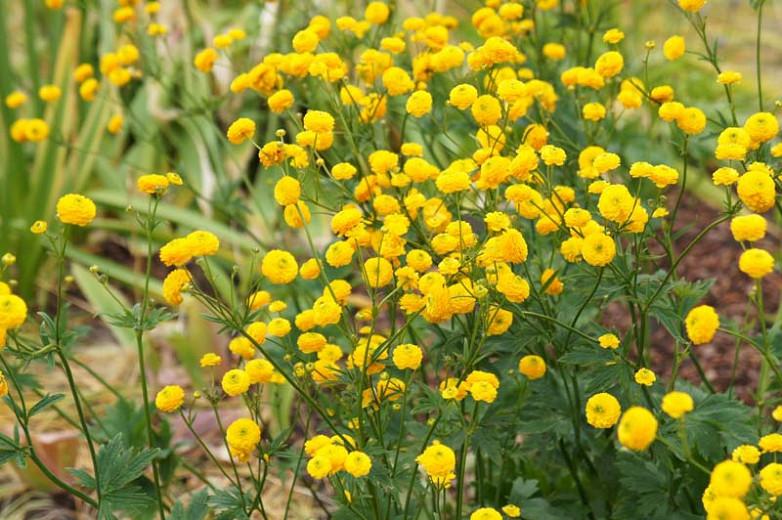Double Meadow Buttercup
Ranunculus acris 'Flore Pleno', Double Meadow Buttercup. Regular price $12.50 View. Ranunculus constantinopolitanus 'Plenus', Double Buttercup. Regular price $16.50 View. Ranunculus gramineus (syn. Granmifolius), Grass Buttercup. From $10.50 View. Award-winning Ranunculus acris 'Flore Pleno' (Double Meadow Buttercup) is an erect, clump-forming perennial bearing a profusion of rosette-like, tightly-double, golden yellow flowers. Blooming late spring to early summer, they rise on leafless flower stems above loose clumps of palmately-lobed leaves. Pot Size: 3-1/2' Height: 6-10' USDA Hardiness Zone: 4: -20ºF through -30ºF, 5: -10ºF through -20ºF, 6: 0ºF through -10ºF, 7: 10ºF through 0ºF, 8: 20ºF through 10ºF, 9: 30ºF through 20ºF.
- Meadow Buttercup Flower
- Double Meadow Buttercup
- Double Meadow Buttercup
- Persian Double Buttercups
- Common Meadow Buttercup
Common Name: Double meadow buttercup
Genus: Ranunculus
Species: acris
Cultivar: 'Flore Pleno'
Skill Level: Beginner
Exposure: Full sun, Partial shade
Hardiness: Hardy
Soil type: Well-drained/light, Clay/heavy, Acidic, Chalky/alkaline, Moist
Height: 100cm
Spread: 50cm
Flowering period: June to July
The long-lasting, button-like, bright yellow, double flowers of this buttercup are a really uplifting sight and will command attention in meadows, cottage gardens or flower arrangements. Unlike the species buttercup, it doesn't spread by underground runners and is more clump-forming, which makes it much more suitable for a garden situation. This plant has been given the RHS Award of Garden Merit (AGM).
Ranunculus (Water-Buttercups)
There are about 600 different wild species of Ranunculus (Latin name Ranunculaceae) and they can be found growing in a vast range of different locations, ranging from submerged water plants to woodlands and mountain scree. Over the years many of these species have been crossed and hybridized providing the garden industry with hundreds and maybe thousands more hybrid cultivars which come in a array of colours. Suitable for growing as ornamental perennials, most of these plants prefer a location which is in full sun. Some of these wild species and their cultivars known as Buttercups, Spearwort’s and Water Crowfoots, are widely used and grown for water gardens and can be categorized as Water Buttercups. They all produce a stunning display of flowers in white and various shades of yellow and not only do they look visually pleasing, but they also provide food for the larvae of many of our British Moths and Butterflies.
Important: – All Buttercups are poisonous to domestic pets, farm animals and humans. I have written this article as a guide to the different Ranunculus that will grow happily in ponds, lakes, streams, bog-gardens, damp woodlands, moist borders and water meadows. Whatever type of water-garden you have, you will find a vast variety of Buttercups that not only look great, but will compliment your garden beautifully.

Ranunculus Ficaria (Lesser-Celandine)
Many of you will be familiar with Celandines as they are common and grow in abundance. Ficaria displays a carpet of bright yellow flowers in early spring (February-March). They are commonly found in ditches and by the edge of streams and damp woodlands, and there are many double and single flowered hybrids with green and brown petal tones and unusual coloured leaves. I once had quite a collection and certainly intend to re-stock these lovely plants once again. These low growing Buttercups are definitely well worth collecting.
Meadow Buttercup Flower
Ranunculus Acris (Meadow-Buttercups)
Double Meadow Buttercup
Also known as Common Buttercups and Meadow Buttercups, Acris are abundant throughout the British countryside colonising meadows, lawns, fields and wild pastures with a show of bright yellow flowers from May to July. They prefer moist but well drained soil, but will tolerate permanent saturated conditions and even months of being underwater during seasonal flooding. There are numerous ornamental hybrids, but my favorite two are Ranunculus Acris Multiplex with its showy very double flowers and, the attractive pale yellow Ranunculus Acris Citrinus.
Ranunculus Lingua (Greater-Spearwort)
This plant has several names, ‘Greater Spearwort’ and ‘Water Spearwort’. This particular Rununculus is a native aquatic marginal plant that grows to a height of 60-100 cm. It has unusual lanceolate leaves and produces large yellow cup-shaped flowers in the height of the summer. It will grow in damp soil or to a water depth of up to 30 cm and looks great when colonised around natural clay bottomed ponds and lakes.
Ranunculus Hederaceous (Ivy-Leafed Crowfoot)
The Crowfoots are submerged oxygenating plants which are terrestrial meaning that they can adapt in times of drought, where they take on a different looking growing habit whilst adapting to muddy margins and moist water banks. This plant as the name suggests produces Ivy shaped floating leaves and very small/minute white flowers and is suitable for ponds and streams in full sun or partial shade. Flowering time is April-May. Water depth is 10-30 cm over the crown.
Ranunculus Aquatilis (Water-Crowfoot)
Double Meadow Buttercup
Another terrestrial plant, this widespread submerged aquatic plant has narrow feathery under water leaves and small green serrated floating leaves that float on the surface. During early summer it puts on quite a stunning show, displaying a carpet of pure white buttercup flowers which they hold a few cm above the water. Aquatilis grows easily in ditches, swamps, ponds, streams and rivers. There are many different species of Crowfoot that can appear quite similar including the very rare ‘Ranunculus Tripartitos’, also known as the (Three Lobed Water Crowfoot). Water Depth is 10-60cm over the crown.
Persian Double Buttercups
Ranunculus Flammula (Lesser-Spearwort)
Common Meadow Buttercup
Another native marginal plant that grows well in bog-gardens and the edge of ponds, it is a very popular and frequently used plant and has a place in all Water Gardens. Flammula has small attractive green leaves and in the height of summer puts on a airy show of dainty small bright-yellow flowers. Water depth is 0-10 cm over the crown.

